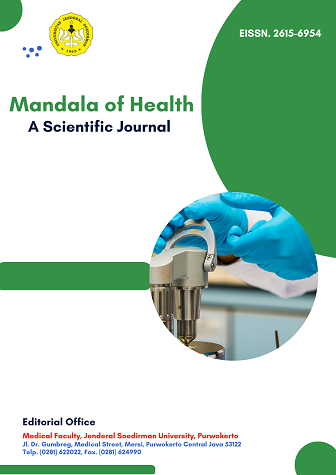STUDI PENDAHULUAN NONTUBERCULOUS MYCOBACTERIA (NTM): PEMBENTUKAN BIOFILM, MOTILITAS GESER, DAN POLA KEPEKAAN ANTIBIOTIK
PRELIMINARY STUDY OF NONTUBERCULOUS MYCOBACTERIA (NTM): BIOFILM FORMATION, SLIDING MOTILITY, AND ANTIBIOTIC SUSCEPTIBILITY PATTERN
Abstract
Nontuberculous mycobacteria (NTM) adalah mikrorganisme yang banyak dijumpai di lingkungan, namun, baru-baru ini dianggap patogen karena kejadian infeksinya meningkat secara signifikan. Penelitian ini bertujuan untuk mengetahui kemampuan pembentukan biofilm isolat NTM, korelasinya dengan sifat motilitas geser, dan untuk menganalisis pola kepekaan antibiotik. Strain NTM yang dipakai dalam penelitian ini adalah 10 isolat klinis NTM yang diperoleh dari laboratorium TB, Departemen Mikrobiologi, Fakultas Kedokteran UGM Yogyakarta. Kemampuan pembentukan biofilm dideteksi dengan menggunakan uji mikrotiter dan pewarnaan dengan kristal violet 1%. Uji motilitas geser dilakukan pada medium motilitas, terdiri dari 0,3% Middlebrook 7H9-agar tanpa suplemen. Pola kepekaan antibiotik diteliti dengan teknik dilusi sesuai metode CLSI. Dari penelitian ini menunjukkan bahwa 7 dari 10 isolat NTM merupakan penghasil biofilm kuat, sementara 1 isolat sebagai strain penghasil biofilm moderat, dan 2 isolat tidak menghasilkan biofilm. Sementara itu, strain pembentuk biofilm mampu melakukan motilitas geser pada agar semisolid, dan 2 isolat NTM yang tidak memiliki kemampuan pembentukan biofilm tidak dapat melakukan motilitas geser. Sifat pembentukan biofilm berkorelasi dengan kemampuan isolat NTM untuk melakukan motilitas geser pada media agar semisolid. Klaritromisin merupakan antibiotik yang paling efektif terhadap isolat NTM yang diuji (poten terhadap 50% isolat uji), diikuti oleh gentamisin (40%), sedangkan kanamisin, levofloxacin, dan ofloxacin menunjukkan tingkat potensi yang sama (30%). Ceftriaxone hanya mampu menghambat pertumbuhan isolat NTM sekitar 20%. Selanjutnya, kotrimoksazol dan amoksisilin memiliki aktivitas in vitro yang buruk terhadap isolat NTM karena tidak ada isolat NTM yang sensitif terhadap kedua antibiotik ini.
Nontuberculous mycobacteria (NTM) are ubiquitous organisms commonly found in the environment. However, recently it is considered as emerging global interest since the incidence increase significantly. This study aimed to investigate the biofilm forming ability of NTM isolates, correlated with the sliding motility properties, and to analyze their antibiotic susceptibility pattern. NTM strain included in this study were 10 NTM clinical isolates obtained from TB laboratory, Microbiology Departement, Faculty of Medicine UGM Yogyakarta. Biofilm forming capability was detected by using biofilm development assay in microtiter plate and staining with 1% crystal violet. Sliding motility assay was performed on motility medium, consisting of Middlebrook 7H9- 0.3% agar without supplements. Antibiotic susceptibility pattern was investigated by macrobroth dilution technique according to CLSI methods. Our study revealed that 7 out of 10 NTM isolates produced biofilm strongly, while 1 isolate demontrated as moderate biofilm former strain, and the remaining 2 isolates did not produce biofilm on polysterene substrate. Meanwhile, biofilm-former strain are able to slide on semisolid agar, and 2 non-adherent NTM isolates did not have ability to perform sliding motility. A good correlation was found between mycobacterial sliding and biofilm assembly of NTM isolates. Clarithromycin has been shown as the most effective antibiotic against NTM isolates tested, which was active against 50% of all isolates, followed by gentamycin (40%), while kanamycin, levofloxacin, and ofloxacin showed the same level of potency (30%). Ceftriaxone was only able to inhibit the growth of NTM isolates about 20%. Furthermore, cotrimoxazole and amoxicillin had poor in vitro activity against NTM species.
References
Brown-Elliott, B.A., Nash, K.A. and Wallace, R.J. 2012. Antimicrobial susceptibility testing, drug resistance mechanisms, and therapy of infections with nontuberculous mycobacteria. Clin Microbiol Rev 25(3): 545-582.
Chee, C.B.E., Khinmar, K.W., Cutter, J., Wang, Y.T. 2012. The imminent threat of multidrugresistant tuberculosis in Singapore. Singapore Med J 53(4): 238-240.
Clinical and Laboratory Standards Institute (CLSI). 2014. Susceptibility Testing of Mycobacteria, Nocardia, and Other Aerobic Actinomycetes M24-A2:1-87. Wayne (PA).
Faria, S., Joao, I. and Jordao, L. 2015. General overview on nontuberculous mycobacteria, biofilms, and human infection. J Pathog : 1-10.
Griffith, D.E., Aksamit, T., Brown-Elliott, B.A., Catanzaro, A., Daley, C., Gordin, F., et al. 2007. An official ATS/IDSA statement: Diagnosis, treatment, and prevention of nontuberculous mycobacterial diseases. Am J Respir Crit Care Med 175(4): 367-416.
Groote, M.A. and De Huitt, G. 2006. Infections due to rapidly growing Mycobacteria. Clin Infect Dis 42(12): 1756–63.
Ley, S., Carter, R., Millan, K., Phuanukoonnon, S., Pandey, S., Coulter, C. 2015. Non-tuberculous mycobacteria: baseline data from three sites in Papua New Guinea, 2010 to 2012. WPSAR 6(4): 24-29.
Martín-de-Hijas, N.Z., García-Almeida, D., Ayala, G., Fernandez-Roblas, R., Gadea, A., Celdran, A., et al. 2009. Biofilm development by clinical strains of non-pigmented rapidly growing mycobacteria. Clin Microbiol Infect 15(10): 931-936.
Maya-hoyos, M., Leguizamón, J., Mariño-ramírez, L., Soto, C.Y. 2015. Production in Mycobacterium colombiense strains. BioMed Res Inter: 1-11
Nan, B. and Zusman, D.R. 2016. Micro review novel mechanisms power bacterial gliding motility. Mol Microbiol 101(2): 186–193.
O’Toole, G.A. 2011. Microtiter dish biofilm formation assay. J Vis Exp (47): 10-11. Schorey, J.S. and Sweet, L. 2008. The mycobacterial glycopeptidolipids: Structure, function, and their role in pathogenesis. Glycobiology 18(11): 832-841.
Sousa, S., Bandeira, M., Carvalho, P.A., Duarte, A., Jordao, L. 2015. Nontuberculous mycobacteria pathogenesis and biofilm assembly. Int J Mycobacteriology 4(1): 36-43.
Stepanovic, S., Vukovi, D., Hola, V., Di Bonaventura, G., Djukic, S., Cirkovic, I., et al. 2007.Quantification of biofilm in microtiter plates: overview of testing conditions and practical recommendations for assessment of biofilm production by Staphylococci. APMIS 115(8): 891-9.
Tang, S.S., Lye, D.C., Jureen, R., Sng, L.H., Hsu, L.Y. 2015. Rapidly growing mycobacteria in Singapore, 2006-2011. Clin Microbiol Infect 21(3): 236-241.
Tortone, C.A., Zumárraga, M.J., Gioffré, A.K., Oriani, D.S. 2018. Utilization of molecular and conventional methods for the identification of nontuberculous mycobacteria isolated from different water sources. Int J Mycobacteriol 7(1): 53-60.
Williams, M.M., Yakrus, M.A., Arduino, M.J., Cooksey, R.C., Cranel, C.B., Banerjee, S.N., et al. 2009. Structural analysis of biofilm formation by rapidly and slowly growing nontuberculous mycobacteria. Appl Environ Microbiol 75(7): 2091-98.






